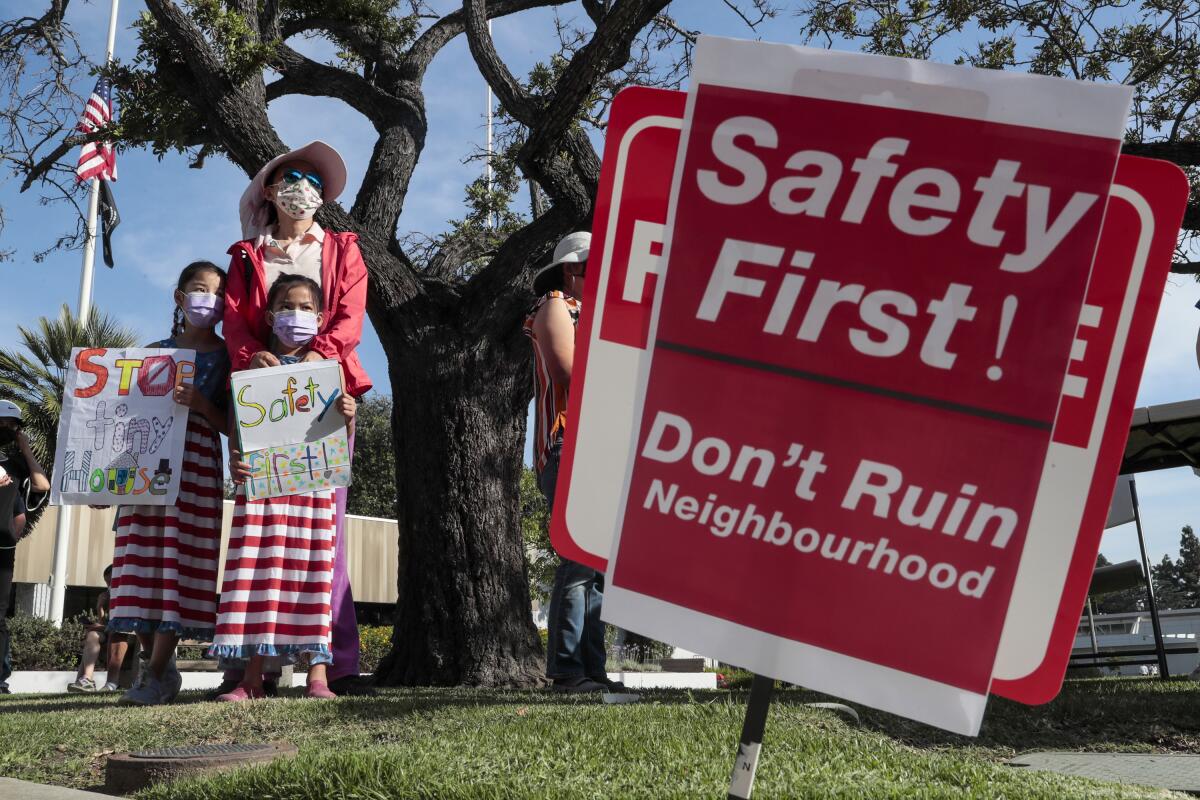Asians in Arcadia against homeless people? It’s complicated

- Share via
On a recent visit, Peck Park was quiet and the water serene and undisturbed as runners and families made their way along the paved path around the lake. Off the road, tents stood under trees where unhoused people lived quietly by the water. The park’s stillness, though, belied the heated debate that broke out last month when the Arcadia City Council discussed plans to build tiny shelters for the homeless population in the city on a small parcel of land there.
The only thing that activists for and against the shelters agreed on was that the one-room dwellings were just a temporary solution that wouldn’t address the larger issues of unaffordable housing. And because the Arcadia City Council decided to table the issue to study it further, it’s unlikely that the project will ever be completed because the grant money that would have funded it has been awarded to other cities instead. As Arcadia’s homeless resource hub closes next month, the status quo will remain, depriving homeless people in Arcadia of a potential place to stay and leaving them with limited options.
Two-thirds of the people in Arcadia are of Asian descent, most of them Chinese, and they were among the most visible protesters who demonstrated in front of City Councilwoman April Verlato’s home last May.
Living in nearby Temple City, this was not the first time I had seen suburban residents protest against subsidized housing or services for unhoused individuals in the San Gabriel Valley. Why are Asians the loudest voices when our own communities have experienced housing discrimination? I initially attributed these reactions to the conservative values within Chinese culture, but as I dug deeper I began to understand the complex spatial geographies that influence the politics of Arcadia and the larger San Gabriel Valley.
The San Gabriel Valley is an “ethnoburb,” a community where mainly Chinese immigrants supplanted neighborhoods that were majority white. The process was not without growing pains. In 1985, Monterey’s City Council attempted to require business owners to use at least some English on their signs, saying it was a response “to pressure from residents disillusioned over the increasing Asian character of their community,” The Times reported.
James Zarsadiaz, an associate professor of history at the University of San Francisco and the co-author of research on the phenomenon of “design assimilation” in the San Gabriel Valley, said some Asian immigrants adopted Western tastes to be accepted in certain neighborhoods and to distinguish themselves as higher status from other immigrants. “They thought that if you have explicitly ‘Asian businesses,’ it’s going to make the community look less affluent, less expensive, less rich, [making it] less desirable,” said Zarsadiaz.
But the discord between the unhoused and housed communities in Arcadia appears to have more to do with class than with race. For many Arcadia residents opposed to tiny shelters, it’s about cultivating a sense of security in the community, which means excluding people whom they think don’t belong. And the homeless population has grown significantly over the past couple of years, jumping from about a dozen to over a hundred.
Throughout interviews, I encountered a fear of homeless people, some of it not grounded in facts. Homeowners worry property values will fall with the presence of tiny shelters and low-income housing. Parents are concerned that unhoused individuals who suffer from mental illness and drug abuse will pose a threat to their children.
One person claimed Los Angeles County was experiencing an influx of homeless individuals from out of state. In interviews and online comments, residents complained that the resource hub Arcadia established for homeless people had attracted more of them to the neighborhood and that the Gold Line provided a direct route for homeless people to move from downtown L.A. into the San Gabriel Valley. One resident even argued that homeless people should be arrested so they would at least be housed in prison.
A 2019 study from Los Angeles Home Services Authority contradicts some of these claims. For starters, more than two-thirds of the people experiencing homelessness have lived in Los Angeles County for more than 10 years, the LAHSA survey found. Other studies debunk the idea that affordable housing lowers property values.
An investigation by The Times found a higher incidence of mental health, substance abuse and health issues among L.A.’s unsheltered homeless population than LAHSA reported. But focusing on personal problems ignores the context of systemic failures to meet people’s needs. In a January report on the history of homelessness in Los Angeles, the UCLA Luskin Center for History and Policy detailed the lack of affordable housing, the erosion of social safety nets, the rising unemployment and the lack of mental health funding in the late ``20th century that are driving the crisis today.
It’s also important to remember that not all Asian Americans opposed tiny shelters in Arcadia.
Carolyn Iga, a longtime local business owner in Arcadia and a staunch supporter of Verlato’s efforts, said she’s had her property stolen in the past, but each time she wasn’t angry. Instead, she was concerned about the societal implications of why people had to steal to get the help they needed.
Yi Ding, a librarian at Cal State Northridge, heard about the controversy from her fellow Chinese American friends living in Arcadia. For her, seeing homeless students in higher education while she worked on textbook affordability made the issue personal. She saw there was a large amount of misinformation shared on WeChat between Chinese-speaking groups. The Xin Sheng Project — formerly known as the WeChat Project — has been a volunteer project through which Ding and the youth-led Sunrise Arcadia have been translating facts about homelessness for Chinese speakers and dispelling some of the myths being circulated.
Juily Phun, a Cal State Los Angeles ethnic studies professor and an educator in the San Gabriel Valley, said the most interesting aspect of the dispute was the Arcadia students, many of them of Asian descent, who chose to support tiny shelters. As she explained, the students leading Sunrise Arcadia also attend Arcadia High School, one of the country’s highest-performing public high schools. “How beautiful and complicated is that?” Phun said of the generational contradictions within Asian American households. “You have these young people who are also the beneficiaries of class privilege, and they’re the same ones who are saying that people deserve rights.”
Although I don’t agree with the logic of those who argued against tiny shelters, I can empathize with the fear and emotion behind many of their statements. The immigrants in Arcadia might think, “I wasn’t born in this country and I managed to make it, why can’t they?” But this “us versus them” mentality ignores the structural inequities in our society that can result in people being in tough situations as victims of circumstance rather than personal choice.
More to Read
A cure for the common opinion
Get thought-provoking perspectives with our weekly newsletter.
You may occasionally receive promotional content from the Los Angeles Times.










